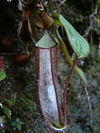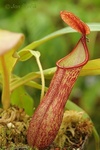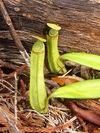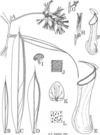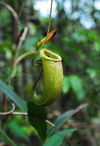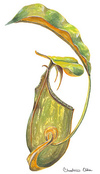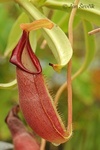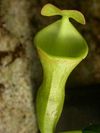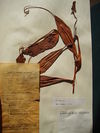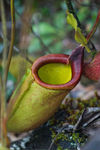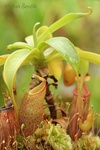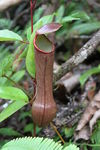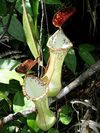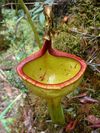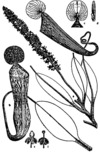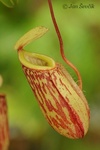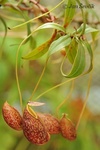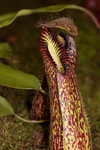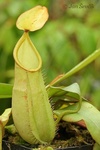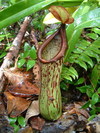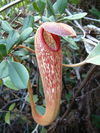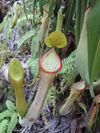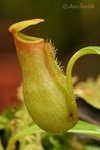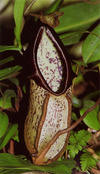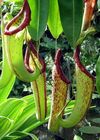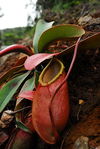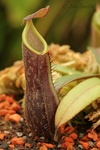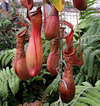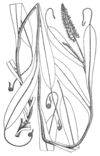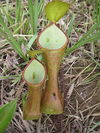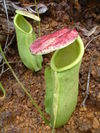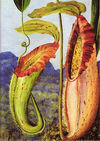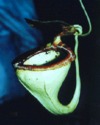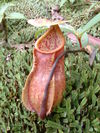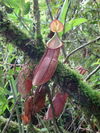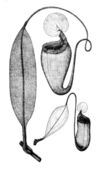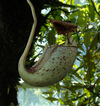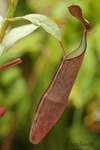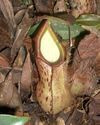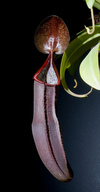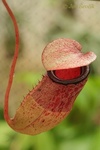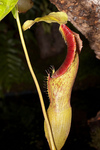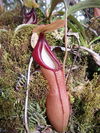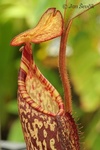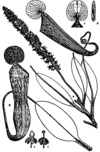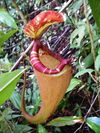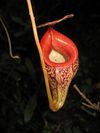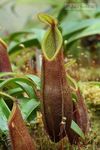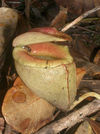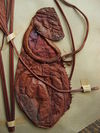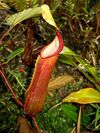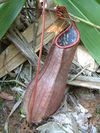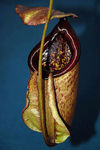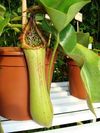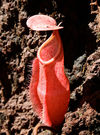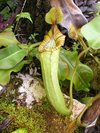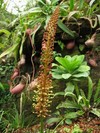Genus nepenthes
The Nepenthes , popularly known as tropical pitcher plants or monkey cups, are a genus of carnivorous plants in the monotypic family Nepenthaceae.Species in the genus nepenthes of plants
Nepenthes adnata - Nepenthes adnata was first collected by Willem Meijer on August 24, 1957.
Nepenthes alata - Nepenthes alata occurs in mossy forest at elevations ranging from 800 to 2,400 m.
Nepenthes albomarginata - Nepenthes albomarginata was first collected by Thomas Lobb in 1848. It was formally described a year later by John Lindley in The Gardeners' Chronicle.
Nepenthes ampullaria - Nepenthes ampullaria generally grows in damp, shady forest from sea-level to 2100 m altitude.
Nepenthes anamensis - The specific epithet smilesii refers to plant collector Frederick Henry Smiles, who made the first known collection of this species.
Nepenthes angasanensis - No forms or varieties of N. angasanensis have been described.
Pitcher Plant - Nepenthes argentii inhabits subalpine shrubbery "with a smooth wind-clipped canopy 30 cm tall on an ultrabasic ridge".
Pitcher Plant - The specific epithet aristolochioides is formed from the genus name Aristolochia and the Latin ending -oides, meaning "resembling". It refers to the similarity that the pitchers of this species bear, in both shape and pigmentation, to the specialised flowers of Aristolochia.
Nepenthes bellii - The specific epithet bellii honours American botanist Clyde Ritchie Bell.
Fanged pitcher plant - Nepenthes bicalcarata was formally described by Joseph Dalton Hooker in his 1873 monograph, "Nepenthaceae", based on specimens collected by Hugh Low and Odoardo Beccari near Lawas River in Borneo.
Pitcher Plant - The species was formally described by Pieter Willem Korthals in his 1839 monograph, "Over het geslacht Nepenthes".
Pitcher Plant - The species was formally described by Pieter Willem Korthals in his 1839 monograph, "Over het geslacht Nepenthes".
Pitcher Plant - Nepenthes burbidgeae was discovered on Mount Kinabalu in 1858 by Hugh Low and Spenser St. John. St. John wrote the following account of finding the species near the Marai Parai plateau:
Nepenthes campanulata - Forest fires destroyed the only known population of N. campanulata in 1983 and it was uncertain whether the species had survived elsewhere or was in fact extinct.
Pitcher Plant - Nepenthes clipeata is probably the most endangered of all Nepenthes species, with only an estimated 15 plants remaining in the wild as of 1995 .
Nepenthes danseri - Nepenthes danseri was formally described in 1997 by Matthew Jebb and Martin Cheek in their monograph "A skeletal revision of Nepenthes ", published in the botanical journal Blumea.
Nepenthes deaniana - N. deaniana has no known natural hybrids. No forms or varieties have been described.
Nepenthes densiflora - No forms or varieties of N. densiflora have been described.
Nepenthes diatas - N. diatas was formally described in 1997 by Matthew Jebb and Martin Cheek in their monograph "A skeletal revision of Nepenthes ", published in the botanical journal Blumea.
Nepenthes distillatoria - Nepenthes distillatoria was the second Nepenthes species to be described, after N. madagascariensis. In 1677, Bartholinus made brief mention of it under the name Miranda herba, Latin for "marvellous herb".
Pitcher Plant - Nepenthes dubia is a tropical pitcher plant endemic to Sumatra. The specific epithet dubia is the Latin word for "doubtful".
Pitcher Plant - The type specimen of N. edwardsiana was collected on Mount Kinabalu in 1858
Pitcher Plant - Nepenthes ephippiata is closely related to N. lowii. Danser described the species based only on part of a stem and a female inflorescence. The form of the pitchers remained unknown until many years later.
Nepenthes eustachya - Nepenthes eustachya is a tropical pitcher plant endemic to Sumatra, where it grows from sea level to an elevation of 1600 m. The specific epithet eustachya, formed from the Greek words eu and stachys , refers to the racemose structure of the inflorescence.
Nepenthes eymae - The specific epithet eymae honours Pierre Joseph Eyma, a Dutch botanist who worked extensively in the Dutch East Indies and who originally discovered the species.
Pitcher Plant - The type specimen of N. faizaliana, Lai & Jugah S 44163, was collected on November 11, 1981, on Batu Panjang in Gunung Mulu National Park. It is deposited at the Forest Herbarium in Kuching, Sarawak .
Nepenthes fallax - The specific epithet stenophylla is formed from the Greek words steno and phylla , and refers to the shape of the lamina.
Pitcher Plant - The specific epithet fusca is derived from the Latin word fuscus, meaning "dark brown" or "dusky", and refers to the colour of the pitchers.
Nepenthes glabrata - The specific epithet glabrata is derived from the Latin word glaber, meaning "hairless", and refers to the mostly glabrous nature of this species.
Nepenthes gracilis - The pitchers of N. gracilis are relatively unremarkable with a very thin peristome and no unusual morphological features. Despite being a widespread plant, natural hybrids between N. gracilis and other species are quite rare.
Nepenthes gracillima - In Nepenthes of Sumatra and Peninsular Malaysia, Charles Clarke lists the natural hybrid N. gracillima × N. macfarlanei. As both N. alba and N. gracillima occur on Mount Tahan, from which Clarke recorded the hybrid, it is unknown which taxon was involved in the cross.
Nepenthes gymnamphora - The specific epithet gymnamphora is derived from the Greek words gymnos and amphoreus .
Nepenthes hamata - In his 1976 guide, Nepenthes of Mount Kinabalu, botanist Shigeo Kurata included this species under the name N. dentata, noting that it was "
Nepenthes hirsuta - N. hirsuta grows at an elevation of 200–1100 m.
Nepenthes hispida - Nepenthes hispida is listed as Conservation Dependent on the 2006 IUCN Red List of Threatened Species.
Pitcher Plant - Nepenthes inermis was first collected on September 7, 1918, by H. A. B. Bünnemeijer on Mount Talang, at an altitude of 2590 m above sea level.
Nepenthes insignis - The first known collection of N. insignis was made by August Adriaan Pulle on November 9, 1912. The specimen, Pulle 277, was collected in southwestern New Guinea at the "
Nepenthes klossii - Nepenthes klossii was discovered in southwestern New Guinea during the Wollaston Expedition of 1912 to 1913. The type specimen of the species, Kloss sn.
Pitcher Plant - Nepenthes lavicola is notable for its very prominent bracts, which often overarch the flowers and may be up to 7 cm long at the base of female inflorescences.
Pitcher Plant - Nepenthes lowii was discovered in March 1851 by British colonial administrator and naturalist Hugh Low during his first ascent of Mount Kinabalu. Low wrote the following account of his discovery:
Pitcher Plant - The following natural hybrids involving N. macfarlanei have been recorded.
Pitcher Plant - Nepenthes macrophylla was once thought to be a subspecies of N. edwardsiana, but differs from that species in several aspects of pitcher and leaf morphology.
Nepenthes macrovulgaris - N. macrovulgaris is most closely related to N. hirsuta and N. hispida, and may be difficult to distinguish from them. Botanists Matthew Jebb and Martin Cheek suggest that N. macrovulgaris is also related to N. philippinensis, a species endemic to Palawan in the Philippines.
Madagascar pitcher plant - Nepenthes madagascariensis was the first Nepenthes species to be discovered; Etienne de Flacourt recorded it in 1658 under the name Amramatico. He published a description of the plant in his seminal work Histoire de la Grande Isle de Madagascar. It reads:
Nepenthes mapuluensis - Nepenthes mapuluensis has no known natural hybrids.
Nepenthes masoalensis - Nepenthes masoalensis is known only from eastern Madagascar; it occurs in the Masoala Peninsula and the Mount Ambato region. It has been recorded from Pandanus and Sphagnum swamps, mountain ridgetops, and xerophytic vegetation.
Nepenthes maxima - In 2009, a cultivar from Lake Poso in Sulawesi was named Nepenthes maxima ‘Lake Poso’.
Nepenthes merrilliana - The species is native to northern and central Mindanao as well as neighbouring Dinagat Island.
Nepenthes mikei - The specific epithet mikei honours Mike Hopkins, who co-discovered the species with the describing authors.
Nepenthes mirabilis - The conservation status of N. mirabilis is listed as Least Concern on the 2006 IUCN Red List of Threatened Species. In Hong Kong, it is a protected species under Forestry Regulations Cap. 96A.
Nepenthes mollis - The habitat of N. mollis is listed as dense forest on a steep slope at an altitude of 1,800 m.
Nepenthes muluensis - Nepenthes muluensis was first collected by Mitsuru Hotta on March 18, 1964, on Mardi between the third and fourth camps on the western ridge of Mount Mulu. The holotype, M.Hotta 14791d, is deposited at the Botany Department of Kyoto University .
Nepenthes murudensis - Nepenthes murudensis was known for some time prior to its description, although authors differed as to its identity. In 1988, Anthea Phillipps and Anthony Lamb suggested that it might represent a natural hybrid between N. reinwardtiana and N. tentaculata.
Nepenthes neoguineensis - Nepenthes neoguineensis was first collected in 1828 by Alexander Zipelius near Triton Bay, New Guinea.
Nepenthes northiana - Nepenthes northiana was first brought to the attention of the scientific community by Marianne North, who painted plants brought to her from the Bau area. Harry Veitch, owner of James Veitch & Sons, recognised these as belonging to an as yet undescribed species and sent Charles Curtis to locate a sample and send seeds to the United Kingdom. The species was subsequently named after Marianne North in 1881 by Joseph Dalton Hooker.
Pitcher Plant - Nepenthes ovata was first collected as early as November 1840 or 1841 by Franz Wilhelm Junghuhn on Mount Lubukraya . Junghuhn collected two specimens at an elevation of 1990 m. Their growth habit is recorded as "in silvis cacuminis supremi scandens, repens", which means "in woods above peak creeping, climbing". One of the specimens, HL.
Nepenthes paniculata - Nepenthes paniculata is probably endemic to Mount Doorman Top in New Guinea . It has been recorded from mossy forest on a ridge top at 1,460 m altitude.
Nepenthes papuana - Nepenthes papuana was first collected on October 7, 1909, by Lucien Sophie Albert Marie von Römer. Two plants were collected on this date on a hill below 750 m altitude, in the northern part of the Noordrivier.
Nepenthes pectinata - The specific epithet gymnamphora is derived from the Greek words gymnos and amphoreus .
Pitcher Plant - The species was originally described as Nepenthes pervillei in 1852, but was later placed in the monotypic genus Anurosperma as Anurosperma pervillei, based on the morphology of its seeds, which differ from the closely allied N. madagascariensis in that they lack the 'tails' characteristic of the rest of the genus. However, the more recent taxonomic database of Jan Schlauer subsumes Anurosperma back into Nepenthes.
Nepenthes pilosa - Nepenthes pilosa is a tropical pitcher plant endemic to Borneo. It is characterised by a dense indumentum of long yellow-brown hairs. Pitchers have a distinctive hook-shaped appendage on the underside of the lid. The specific epithet derives from the Latin word pilosus, meaning "hairy".
Tropical Pitcher Plant - Nepenthes rafflesiana is a very widespread lowland species. It is common in Borneo and parts of the Riau Archipelago, but has a restricted distribution in both Peninsular Malaysia and Sumatra. It is only widespread in the southeastern region of the Malay Peninsula, particularly in the state of Johor, where it is relatively abundant. Nepenthes rafflesiana has only been recorded from the west coast of Sumatra, between Indrapura and Barus.
Pitcher Plant - N. rajah was first collected by Hugh Low on Mount Kinabalu in 1858, and described the following year by Joseph Dalton Hooker, who named it after James Brooke, the first White Rajah of Sarawak. Hooker called it "one of the most striking vegetable productions hither-to discovered". Since being introduced into cultivation in 1881, Nepenthes rajah has always been a much sought-after species. For a long time, the plant was seldom seen in private collections due to its rarity, price, and specialised growing requirements. However, recent advances in tissue culture technology have resulted in prices falling dramatically, and N. rajah is now relatively widespread in cultivation.
Nepenthes ramispina - N. macfarlanei × N. ramispina
Nepenthes reinwardtiana - Nepenthes reinwardtiana has an unusually wide altitudinal distribution of 0–2200 m, being both a "lowland" and "highland" plant. There are many different colour forms, ranging from green to dark red. This species is known for the two "eye spots" on the inside surface of its pitchers.
Nepenthes rhombicaulis - Nepenthes rhombicaulis was first collected by Shigeo Kurata on March 29, 1972, on Mount Pangulubao at an altitude of between 1700 and 1900 m above sea level. The species was mentioned by name in a 1972 issue
Nepenthes sanguinea - This highland pitcher plant can be grown on a windowsill or in partly shaded areas outside, as well as in a terrarium, provided that it is large enough to accommodate this Nepenthes.
Nepenthes sibuyanensis - Nepenthes sibuyanensis was discovered during an expedition to the Philippines beginning in September 1996. The team comprised Thomas Alt, Phill Mann, Trent Smith, and Alfred Öhm. The species was formally described
Nepenthes singalana - In 2001, Charles Clarke performed a cladistic analysis of the Nepenthes species of Sumatra and Peninsular Malaysia using 70 morphological characteristics of each taxon. The following is part of the resultant cladogram, showing "Clade 3", which comprises N. singalana and three other related species.
Nepenthes spathulata - One of the first collections of N. spathulata was made by Maurits Anne Lieftinck. The specimen Lieftinck 11 was collected in January 1935
Nepenthes spectabilis - The first known collection of N. spectabilis was made by Julius August Lörzing in 1920. The specimen Lörzing 7308 was collected on June 5, 1920, on Mount Sibajak at an altitude of 1800 to 1900 m. It is deposited at the Bogor Botanical Gardens along with two isotypes which include both male and female floral material. A third isotype, sheet HL.
Nepenthes stenophylla - The specific epithet stenophylla is formed from the Greek words steno and phylla , and refers to the shape of the lamina.
Nepenthes sumatrana - Nepenthes sumatrana was first collected by Johannes Elias Teijsmann in February 1856, near the port town of Sibolga.
Nepenthes talangensis - auct. non Korth.: Jebb & Cheek ;
Nepenthes tentaculata - The specific epithet tentaculata is derived from the Latin word tentacula, meaning "tentacles", and refers to the multicellular appendages on the upper surface of the pitcher lid.
Nepenthes tenuis - Nepenthes tenuis was first collected by Willem Meijer on August 24, 1957.
Nepenthes thorelii - The first known collection of N. thorelii was made by Clovis Thorel between 1862 and 1866
Nepenthes tobaica - Nepenthes tobaica is closely related to N. angasanensis, N. gracilis, N. mikei, and N. reinwardtiana.
Nepenthes tomoriana - Nepenthes tomoriana holotype
Nepenthes treubiana - This species occurs on the cliffs of the McCluer Gulf and in coastal regions of the Fak Fak peninsula.
Nepenthes truncata - On September 29, 2006, at the Botanical Gardens in Lyon, France, a Nepenthes truncata was photographed containing the decomposing corpse of a mouse. This incident is the first record of a mammal being successfully trapped in the pitchers of N. truncata. Both N. rajah are known to occasionally catch small mammals in the wild.
Nepenthes veillardii - Nepenthes vieillardii is a species of pitcher plant endemic to the island of New Caledonia. Its distribution is the most easterly of any Nepenthes species. Its natural habitat is subtropical or tropical dry forests.
Nepenthes veitchii - Frederick William Burbidge described the growth habit of N. veitchii in The Gardeners' Chronicle as follows:
Nepenthes ventricosa - Nepenthes ventricosa is very closely related to both N. burkei and N. sibuyanensis, but can be distinguished by a more waisted middle to the pitchers, a smaller mouth, and, generally, a thinner peristome.
Pitcher Plant - The specific epithet villosa is Latin for "hairy" and refers to the dense indumentum of this species.

